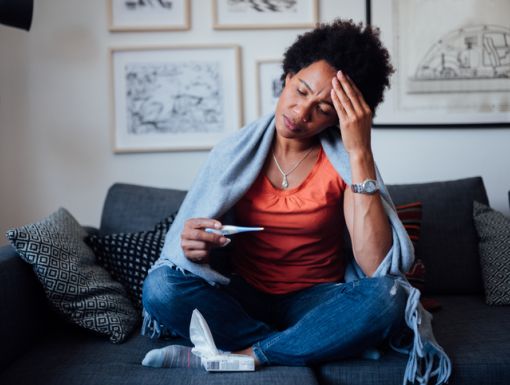
Can I Exercise with COVID-19?
If you have been diagnosed with COVID-19, you may have a lot of questions about what you “should” or “shouldn’t” do to make recovery easier. Today we are addressing one of the most common questions our physical therapists receive: Is it OK to work out when I have COVID-19?
The brief answer is yes – and no. Because every person and COVID case is different, whether you should begin incorporating exercise into your day will vary based on your symptoms.
If you are still feeling unwell and experiencing COVID symptoms of fever, nausea, shortness of breath, dizziness or extreme fatigue, it is not advised to resume any regular exercise regimen.
If you are asymptomatic or are feeling well enough in your recovery to add exercise back into your routine, your body could likely benefit from some added movement. Gently increasing your mobility can help with stiffness and body aches associated with COVID-19. Don’t head back to the gym or group classes until you are outside of your isolation period.
Easing back into your regimen during recovery is the best approach, so consider the following before firing up the elliptical.
Consider your oxygen levels
It is important to keep in mind that COVID-19 can impact the respiratory system, so ensuring you are getting enough oxygen during exercise is more important than ever when you are recovering.
If you have one, a great option to monitor your oxygen is a home pulse oximeter, which is a device that clips onto your finger to measure your heart rate and oxygen levels in your red blood cells. You should look for an oxygen level of 93% or higher at all times for any standing activities. If the level dips below this rate, sit down and consider taking a break or modifying your exercise.
If you don’t have a pulse oximeter at home, stay attuned to your breathing and look for symptoms that could indicate reduced oxygen levels, like lightheadedness, dizziness or extreme fatigue.
Take a lighter approach
COVID-related fatigue can linger into recovery for six to eight weeks – or longer – for some. Feeling tired all the time can put a damper on your best laid plans for movement.
Remember that daily life responsibilities require energy as well. You may want to conserve some stamina for these tasks or use them as opportunities to ease into movement rather than returning immediately to traditional workouts.
When developing your recovery regimen, consider your previous exercise routine and lighten it up. Reduce your pace, lower resistance and weight levels or even consider a modified stance, like sitting or lying down instead of standing. A good rule of thumb is to start with about half of your previous exertion level and adjust to your comfort from there.
Monitor your exertion
Once you start moving, it is a good idea to continually take stock of how you are feeling and monitor your body’s cues. In physical therapy, we use a scale of zero to 10 to help patients determine their level of exertion.
Before your diagnosis, you may have been able to run a mile without breaking a sweat. But now that you’re recovering, that same mile and pace may feel a lot more difficult. This is completely normal. While starting to exercise again, check in with yourself regularly to evaluate your level of difficulty. Use the following chart as a guideline to help you self-evaluate.

In recovery, it is important to not exceed a 5 on the scale of difficulty. Staying with the 3-5 range ensures you will challenge your body safely, pace yourself appropriately and conserve energy. Remember, if it feels too difficult, your body isn’t yet ready; try modifying your exercise or taking a rest.
Nourish yourself
It may be common knowledge that COVID can rob you of your taste and smell, but you may not know that this can lead to poor nutrition. Because food is no longer as appealing, those who report a loss of taste or smell may later suffer from nutritional insufficiency.
Your body needs fuel to exercise, so make sure you are incorporating nutritious protein, fruits and vegetables and healthy fats into your diet before you get back to your workout. And don’t forget to hydrate with lots of water – your body not only needs it to exercise, but also to recover from infection.
Getting started
If you’ve taken these things into account and are ready to get moving again, you may want to look for low-intensity exercises to get started. Here are some therapist-approved ways to add movement during recovery:
- Walking: We all know that slow and steady wins the race, and this is especially true during recovery. Walking gets your heart rate going and is a heart-healthy option for low-intensity cardio. A walk around the block – or even a couple laps around the kitchen island – is a great place to start.
- Strengthening: Forget the weights while you’re recovering. Try a few body-weight exercises to improve your strength while seated or lying down. Bicep curls, leg lifts and core twists will get your muscles going without overdoing it.
- Breathing: While not necessarily a “workout,” consider incorporating breathing exercises into your recovery regimen. Deep breathing not only helps your body get the oxygen it needs, but it can also have a calming effect and bust those COVID blues. Check out some of our breathing exercises here.
- Stretching and balance exercises: Stretching is essential in keeping your muscles flexible, and balance is what improves your stability to help prevent falls. These work in tandem to get your muscles primed and ready for adding movement back into your lifestyle. Yoga is an excellent method of practicing both! Get started with one of these low-intensity yoga videos led by occupational therapist and certified yoga instructor Lauren Siegel from Ochsner’s Functional Restoration Program.
If you need additional support during your COVID-19 recovery, please call 504-842-4348 to schedule a consultation with our specialized COVID recovery therapy team.
Editor's note: This blog was originally published on Jan. 14, 2022 and has since been updated.


